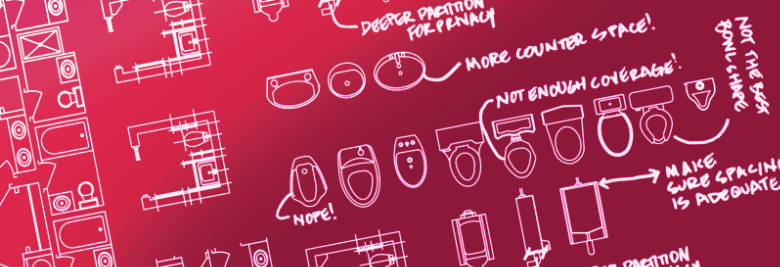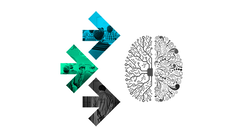Feeling Flush?

Cutting corners on restroom design carries a high cost
We’re fresh off our presentation at the Academy for Neuroscience in Architecture (ANFA)’s 2018 conference, so we’re thinking about human needs on the biological level. Chief among them? We all need a moment to ourselves from time to time. Historically, the office restroom has not served us particularly well. In this month’s “On our minds”, we talk about the benefits of thoughtful design, and share our ten point guide to designing a restroom that actually offers a bit of respite.
On our minds
Time for some real potty talk: most workplace restrooms stink.
This isn’t just about smell though; the whole experience leaves much to be desired. Intended to accommodate one of the most basic of human needs, these spaces are frequently cold (in temperature and in design), institutional, and generally unpleasant. Shouldn’t we expect more from a setting we call the ‘throne’?
Savvy readers will recall that our article on this topic got some attention back in 2016. Since then, many have asked for some practical guidance, to which this newsletter is a response. Our previous piece laid it out why all this matters:
"In contrast to the lofty declarations of mission statements that are both easy to craft and to ignore, investments in spaces are more transparent reflections of managers’ actual perspective. In this sense, the design and upkeep of a restroom plays a crucial role in the relationships between managers, employees, and clients."
Sub-par restroom experiences have an impact on users. For example, being aware that a coworker is sitting in the next stall can make people uncomfortable. Preparing for a big presentation without being able to check one’s appearance in a decent mirror can increase anxiety. A restroom without a space to actually rest, like a lounge, leaves people with very little respite from the hubbub of the office—to whit, some people are actually going to the restroom to work because it’s the one place they can get some peace and quiet.
These discomforts don’t magically disappear when people return to their desks, but they can be mitigated by design that puts the needs of users first. Here is PLASTARC’s ten-point guide to creating a restroom that people love to use.
Fully-enclosed cabins
It might surprise people who’ve only used American restrooms, but restrooms in other places don’t look like the ones in the US. One difference that’s immediately clear is that the stall partitions are frequently built floor-to-ceiling, offering greater sensory privacy. We’d like to see more workplaces follow the lead of companies like WeWork, who have universally adopted this practice.
Hands-free everything
It is almost impossible to leave the restroom with clean hands. Depending on your perspective, you’re either getting your germs on the doorknob or getting the doorknob’s germs on you. Now add that phone, laptop, or whatever else you carried in; you’re juggling, trying not to become the "before" person in a late-nite infomercial. Doors especially don’t have to be operated with your hands. With the right hardware, they could be opened with a forearm or a foot.
Multisensory basics
We love multisensory resimercial design. In the home, the restroom is often a haven, decorated with carefully-chosen colors, cloth linens, and beautiful fixtures. Why not make the office restroom more like this? Appearance matters, but don’t forget about the other senses. A white-noise generator (waterfall) or music contributes to the sense of privacy. Unpleasant odors should be addressed with proper ventilation and better-smelling alternatives. You might even consider heated seats.
Obey the laws of gravity
Soap dispensers between sinks tend to result in little piles of soap on the counter or floor. Electric hand dryers, often attached to a wall in a quasi-random location, result in a floor that’s always wet. Instead, place liquid soap dispensers above sinks, and put hand dryers above a tray—or select dryers that are designed to recapture the water they’re blowing off people’s hands.
Non-gendered cabins
This is a big one. To see a glaring example of the inequity common in restroom allocation, visit almost any stadium or theater; witness the huge line for the women's restroom, while the men walk right in. Why not dodge that problem entirely with a single bank of ungendered stalls and a shared washing area, à la Ally McBeal?
A bonus: this arrangement also takes advantage of the same simple principle Steve Jobs reportedly used when planning the Pixar studios: when people come face to face more often, they interact more. Like a communal lunch table, the restroom can encourage spontaneous interactions that build rapport and ease the flow of information. Regrettably, it won’t lead to any Barry White dance numbers. Probably.
Occupado, non-occupado
Airplane restrooms are not know for comfort, but they have had the 'in-use' issue sorted for years. A person who wants to use a stall should be able to see at a glance whether it is available. They shouldn’t have to knock on every stall door, listen for rustling, or bend over to look for feet! One more thing the airlines get right: you basically can’t use the restroom without locking the door, since the lock also turns on the light.
Speaking of lights…
Don’t leave people in the dark!
Motion-sensing light switches are really great for saving energy. However, sometimes they are set too aggressively, and can shut off when a person is still sitting there. Then the occupant has to wave their arm or do some other maneuver to get a few more minutes of illumination. Please do conserve electricity, but design the lighting so it doesn’t assume a person at rest ceases to exist!
Hooks, holders, and shelves
People have stuff. Mobile devices, clothing, baby accessories, cups of coffee, and other odds-and-ends don't dissapear when we enter a toilet. If the typical restroom has any shelves at all, they may be behind the user or even above the head—instead of front and center where they would be most useful. People should be able to put all their stuff in one place, know that it won’t walk away, and be prevented from leaving it behind by accident.
Lounge and work areas for ladies (and men!)
In almost any business context, people want to know that they look professional. Restrooms for both men and women should have full-length mirrors. They should also have comfortable seating. People with long commutes or those trying to squeeze exercise into a busy work life will appreciate having a quiet space to rest, regroup, change clothes if needed, and make sure they’re ready to put their best foot forward.
Easy maintenance
Last, but certainly not least, facilities must be easy to clean and maintain. While landlords typically decide how restrooms are designed and equipped, the costs of upkeep—or the social costs of an unpleasant experience—are borne by occupants. While it may seem challenging to balance comfort and ease-of-maintenance, more and more manufacturers are bringing products to market that blend commercial durability with the comfortable aesthetics of home.
The restroom is a litmus test for workplace experience. A space designed for comfort—or even delight—is evidence that an employer is thinking about the needs and wants of occupants. With a bit more thought, the ol’ water closet can be made welcoming and more accommodating of the full range of human needs. It’s time to go beyond the ‘necessary’ and equip our workplaces with restrooms that are a joy to use.
From the archives
Digging a little deeper, we found this 2015 piece from Architect Magazine, in which Founder Melissa Marsh talks about the ‘whys’ and ‘hows’ of social-centric design.
That about does it for this month—we’ll leave you with one final thought. Over half a century ago, American law decided that it was time to remove racial separation from toilets and drinking fountains. Gender imbalance is still written into many things, including building codes. We’d love to hear what you think; are we ready to provide everyone with the same great restroom experiences?
In Case You Missed It
Whether sharing our research at the Salk Institute, building community in Kings Cross, or diving into the future of workplace technology in sunny Singapore, we’ve been busy. Here’s the latest:

PLASTARC shares findings at ANFA 2018
We were thrilled to present our findings at ANFA once again. Our latest research focused on amenities and spaces for work-life integration.

Can Creativity Thrive in an Open Office?
PLASTARC was featured in this thought-provoking piece by Artsy, which emphasizes the importance of allowing people to choose privacy, especially in open plan offices.

CoreNet Global’s "What’s Next?" Podcast
PLASTARC Founder Melissa Marsh and Chris Hallas of Comfy recapped their session about technology and workplace performance at the CoreNet Global Summit in Singapore.

Sarah Wilen joins the team
Meet Sarah, one of our newest team members. She’s a sociospatial analyst, using the latest social science and behavioral research to improve spaces. Welcome, Sarah!
Looking Ahead
We’re always on the hunt for the latest and greatest in workplace design research, trends, and technologies. This month is no different!




